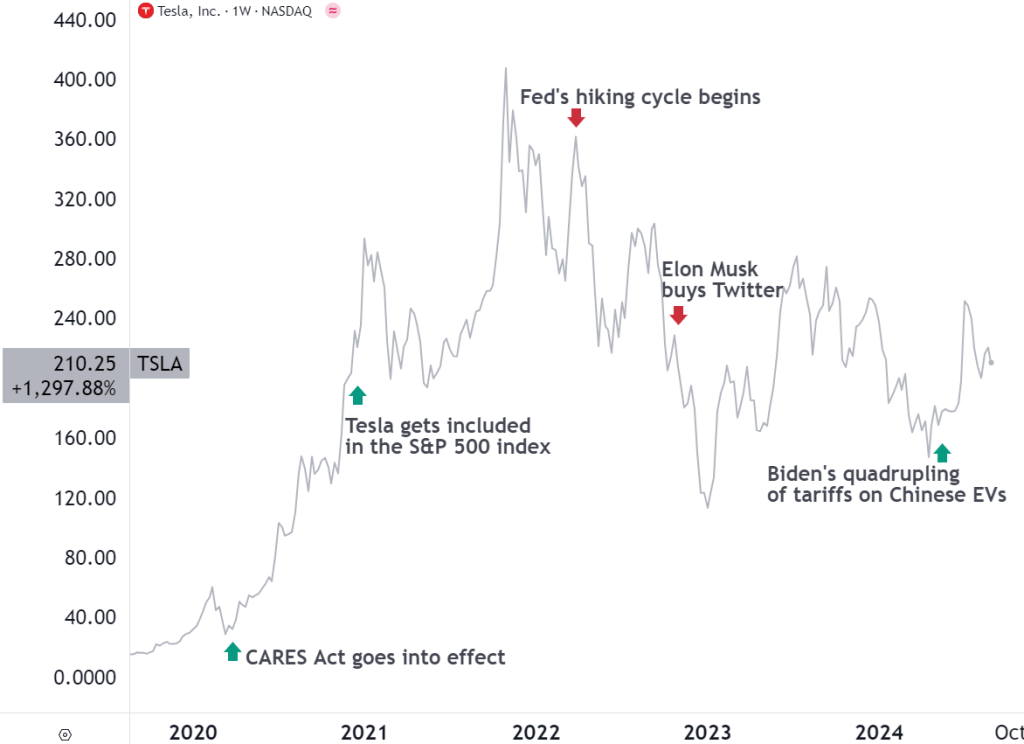Over the last few months, it has become clear that the electric vehicle (EV) industry is transitioning from heavy government subsidies to greater emphasis on regional protectionism. In July, the EU ramped up its eurozone protection by imposing tariffs on Chinese BYD (SZ:) (+17.4%), Geely (+19.9%), and China’s state-owned SAIC (up $37.6%), which collaborates with Baidu (NASDAQ:) to develop its Apollo Go robotaxi service.
At the same time, the European Commission slashed tariffs on China-built Tesla (NASDAQ:) EVs from 20.8% to 9%. Most recently, Canada joined the trend as it will place a 100% tariff on China-made EVsin addition to aluminum and steel exports by 25%, as of October 1st and October 15th, respectively.
Due to US-imposed tariffs on Chinese EVs and batteries in May, this translates to higher prices for end-consumers. For example, if BYD’s Seagull has a $12k price tag, it is unlikely that non-Western customers would be able to enjoy such affordability, a challenge that has consistently hindered the mass adoption of EVs.
China’s success in scaling efficiency was the focus of Morgan Stanley’s recent reshuffling of TSLA exposure.
Has Morgan Stanley Gone Bearish on Tesla?
After first introducing TSLA stock to its portfolio in March 2021, Morgan Stanley increased its exposure in September and December 2022. The first TSLA cutback happened in November 2023, after which TSLA shares suffered a steady decline until June.

It was at this point that Tesla shareholders approved Elon Musk’s $48 billion compensation package. Likewise, June’s rally coincided with the Tesla event in Austin, at which point Musk speculated that the company’s valuation could grow as high as $30 trillion, “Once Tesla fully solves autonomy and has Optimus in volume production, anyone still holding a short position will be obliterated.”
However, last week, Morgan Stanley strategists begged to differ due to “continued slowdown in the auto industry, intense competition among electric vehicles (EVs) and reduced consumer preferences”.
The slowdown is a reference to the rising credit delinquency rate, the highest since Q4 2011, and high costs of living sparked by inflation. And the intense competition is a reference to BYD’s Seagull as the harbinger of Chinese scaling operations to pierce through the EV affordability problem.
Although Morgan Stanley strategists still view Tesla as growth exposure to AI, energy storage and robotics, they would rather opt out for less riskier Spotify (NASDAQ: NYSE:). The latter effectively employed a freemium approach to grow its monthly active user count to a massive 626 million as of Q2 2024 earnings report.
Moreover, it seems that Baidu with its Apollo Go robotaxi service and RT6 EVs is ahead of the robotaxi game. In collaboration with state-owned Jiangling Motors Group, RT6 costs half as much as the prior generation at ~$27.7k. In the latest Q2 earnings, Baidu revealed that its autonomous hailing service already covers the entire Wuhan municipality, with 1,000 RT6s added by the end of the year.
In the West, it is still unclear if such a regulatory framework that allows for autonomous driving is feasible on a federal level. This is just one of the reasons why even some long term investors are jumping the Tesla ship.
Selling EVs at Scale Trumps Futuristic Humanoid Robotics
Ross Gerber is the co-founder and CEO of Gerber Kawasaki Wealth and Investment Management. In a Yahoo Finance interview on August 23rd, Gerber noted that his fund still has a $50 million worth of TSLA exposure.
The long-time Tesla shareholder has been steadily reducing it, however, having sold 60 million TSLA shares since Musk’s acquisition of Twitter. The main culprit seems to be the shift from selling EVs at scale to rather vague talk of robotics and self-driving.
“That’s just a distraction from the fact that they need to sell cars, this year, and next year, and the year after, because none of this is coming anytime soon,”
Gerber further noted the resale value problem of EVs. According to an iSeeCars survey in November 2023, Tesla EVs Model S and Model X lost more value than average luxury vehicles over a 5-year span. Case in point, Model S lost ~$60k vs its MSRP.
When it comes to Tesla’s prospective growth in robotics and AI, the company is projected to spend about $10 billion in 2024 alone, effectively boosting Nvidia’s bottom line. For Gerber, this aspect of Tesla operations, coupled with humanoid robotics, is a pie in the sky.
“The simplest way to do it is, go around to your neighbors and ask them, ‘How many of you would buy a humanoid robot built by Elon Musk?’ And the answer is zero, OK. Nobody wants a robot from Elon Musk. Why? Who would trust it?”
Although this appears to be a dismissal based on vague emotions about other people’s state of mind, it is true that even Elon Musk considers generalizable humanoid robots as extremely challenging.
With that said, some robotics experts have noted that the Tesla Optimus team has gained much ground all the way back in 2022. Director of RoMeLa: Robotics & Mechanisms Laboratory, prof. Dennis Hong, noted that he is “cautiously optimistic”, with a large caveat that mass production would be a mistake because “I do not believe that is the one that can be used in a real world setting in any meaningful capacity.”
On the positive side, if Musk’s full self-driving (FSD) gambit succeeds into a full-blown robotaxi service, Cathie Wood projects TSLA shares to balloon to $2,600 by 2029, as then the bulk of Tesla’s revenue would come from value-added services.
Of course, for that to happen, Tesla would still have to efficiently scale EVs and significantly cut their costs, just as Baidu did with the latest RT6 generation. Much will be revealed at the Tesla robotaxi event in October, previously scheduled for August but delayed due to “important design change“.
***
Neither the author, Tim Fries, nor this website, The Tokenist, provide financial advice. Please consult our website policy prior to making financial decisions.

